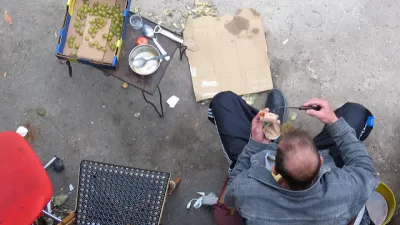As cities struggle to deal with the persistent challenges of homelessness, one writer suggest there's a better way to address the problem than by simply clearing out homeless encampments and tent cities.
Lisa Daugaard notes that shutting down homeless encampments might feel like progress, but "it is not an effective choice if the goal is actually reducing the number of people living outdoors." In fact, "[i]n the absence of real alternative accommodations for people currently camping outside, these closures are counter-productive flailing that do far more harm than good."
The ongoing controversy inspiring the article by Daugaard concerns "The Jungle" (also known as the Beacon Hill greenbelt) in Seattle. According to Dauggard, the real question that should be asked when deciding the best policies to address homeless encampment follows: "How can we best and most quickly get to a point where people don’t have to resort to living outdoors?"
Dauggard provides five answers to that question, each with more detail included in the article:
- Rethink the camp closure approach.
- Improve city services in encampments.
- Build relationships.
- Employ harm-reduction techniques that work.
- Develop more inclusive housing options.
FULL STORY: 5 real fixes for homeless encampments

Alabama: Trump Terminates Settlements for Black Communities Harmed By Raw Sewage
Trump deemed the landmark civil rights agreement “illegal DEI and environmental justice policy.”

Planetizen Federal Action Tracker
A weekly monitor of how Trump’s orders and actions are impacting planners and planning in America.

The 120 Year Old Tiny Home Villages That Sheltered San Francisco’s Earthquake Refugees
More than a century ago, San Francisco mobilized to house thousands of residents displaced by the 1906 earthquake. Could their strategy offer a model for the present?

In Both Crashes and Crime, Public Transportation is Far Safer than Driving
Contrary to popular assumptions, public transportation has far lower crash and crime rates than automobile travel. For safer communities, improve and encourage transit travel.

Report: Zoning Reforms Should Complement Nashville’s Ambitious Transit Plan
Without reform, restrictive zoning codes will limit the impact of the city’s planned transit expansion and could exclude some of the residents who depend on transit the most.

Judge Orders Release of Frozen IRA, IIJA Funding
The decision is a victory for environmental groups who charged that freezing funds for critical infrastructure and disaster response programs caused “real and irreparable harm” to communities.
Urban Design for Planners 1: Software Tools
This six-course series explores essential urban design concepts using open source software and equips planners with the tools they need to participate fully in the urban design process.
Planning for Universal Design
Learn the tools for implementing Universal Design in planning regulations.
Clanton & Associates, Inc.
Jessamine County Fiscal Court
Institute for Housing and Urban Development Studies (IHS)
City of Grandview
Harvard GSD Executive Education
Toledo-Lucas County Plan Commissions
Salt Lake City
NYU Wagner Graduate School of Public Service




























